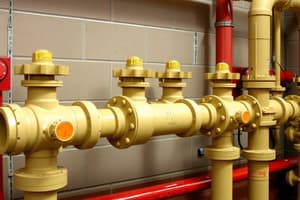Podcast
Questions and Answers
What is the primary purpose of Class II standpipe systems?
What is the primary purpose of Class II standpipe systems?
- To allow building occupants to manage small fires before help arrives. (correct)
- To facilitate quick evacuation of occupants during a fire.
- To serve as a backup water source for sprinkler systems.
- To provide a water supply for fire department use during major fires.
In what type of buildings are Class II systems typically allowed?
In what type of buildings are Class II systems typically allowed?
- Industrial buildings with frequent fire hazards.
- High-rise commercial buildings with high fire loads.
- All public assembly buildings regardless of fire load.
- Fully Sprinklered buildings or residential/low-hazard occupancies. (correct)
What flow rate is typically associated with Class II standpipe systems?
What flow rate is typically associated with Class II standpipe systems?
- 400-500 gpm.
- 100 gpm. (correct)
- 75 gpm.
- 150-200 gpm.
What feature differentiates Class III standpipe systems from Class II systems?
What feature differentiates Class III standpipe systems from Class II systems?
What is the primary benefit of a Class III standpipe system in high-rise building fires?
What is the primary benefit of a Class III standpipe system in high-rise building fires?
Why does the NFPA recommend placing occupant use hoses outside the stairwell?
Why does the NFPA recommend placing occupant use hoses outside the stairwell?
What flow rate can a Class II standpipe system potentially require during wind-driven apartment fires?
What flow rate can a Class II standpipe system potentially require during wind-driven apartment fires?
What is the primary intent of having separate valves for different hose sizes in a Class III standpipe system?
What is the primary intent of having separate valves for different hose sizes in a Class III standpipe system?
What is the primary purpose of the pressure-reducing device depicted in Class III systems?
What is the primary purpose of the pressure-reducing device depicted in Class III systems?
Why should fire departments assess the impact of opening a stairway door?
Why should fire departments assess the impact of opening a stairway door?
Which factor limits the effectiveness of occupant-use hoses for untrained users?
Which factor limits the effectiveness of occupant-use hoses for untrained users?
What pressure is deemed safe for untrained users utilizing a 1½-in. first-aid hose according to the mentioned standards?
What pressure is deemed safe for untrained users utilizing a 1½-in. first-aid hose according to the mentioned standards?
According to NFPA 14, what is the minimum pressure required at 2½-in. outlets for structures built after 1993?
According to NFPA 14, what is the minimum pressure required at 2½-in. outlets for structures built after 1993?
What can untrained occupants' immediate response to a fire often lead to?
What can untrained occupants' immediate response to a fire often lead to?
What is a limitation of using 2½-in. outlets for connections involving 1½-in. hoses?
What is a limitation of using 2½-in. outlets for connections involving 1½-in. hoses?
What is the required pressure range for fire department hoses with fog nozzles?
What is the required pressure range for fire department hoses with fog nozzles?
What is the primary function of a simple orifice plate in a firefighting system?
What is the primary function of a simple orifice plate in a firefighting system?
What happens to static pressure when the nozzle is closed while using a simple orifice plate?
What happens to static pressure when the nozzle is closed while using a simple orifice plate?
How does the vane-type pressure relief valve (PRV) control stream restriction?
How does the vane-type pressure relief valve (PRV) control stream restriction?
What is the least significant action to take before connecting a fire department hose to a standpipe?
What is the least significant action to take before connecting a fire department hose to a standpipe?
What is a critical precautionary step when preparing to connect hoses to a standpipe?
What is a critical precautionary step when preparing to connect hoses to a standpipe?
Why should a member controlling the outlet valve be in communication with the nozzle team?
Why should a member controlling the outlet valve be in communication with the nozzle team?
What is a characteristic of the vane-type PRV even when fully opened?
What is a characteristic of the vane-type PRV even when fully opened?
What is the name of the pressure reducing valve that involve combination outlet control and pressure reducing valves?
What is the name of the pressure reducing valve that involve combination outlet control and pressure reducing valves?
What percentage of pressure reducing devices failed at one major metropolitan city?
What percentage of pressure reducing devices failed at one major metropolitan city?
What should the member controlling the outlet use to determine if he/she has opened the valve far enough to supply the needed pressure?
What should the member controlling the outlet use to determine if he/she has opened the valve far enough to supply the needed pressure?
Instead of pressure reducing devices what should the FD recommend for controlling pressure?
Instead of pressure reducing devices what should the FD recommend for controlling pressure?
The primary distinction between classes of standpipes is the intended _____
The primary distinction between classes of standpipes is the intended _____
Many jurisdictions allow class 2 systems if the building is ____ sprinkled or in residential and other “_____” in terms of fire load not life hazard or frequency of fires
Many jurisdictions allow class 2 systems if the building is ____ sprinkled or in residential and other “_____” in terms of fire load not life hazard or frequency of fires
For structures built after 1993 NFPA allows up to __ psi at 2 1/2 in outlets but still allows__ psi as the minimum pressure
For structures built after 1993 NFPA allows up to __ psi at 2 1/2 in outlets but still allows__ psi as the minimum pressure
___ gpm is the max flow from pressure reducing devices
___ gpm is the max flow from pressure reducing devices
Flashcards
Class II Standpipe
Class II Standpipe
Designed for building occupants to control small fires until the fire department arrives.
Class II Hose Capacity
Class II Hose Capacity
Limited to 1/2-inch hose with a maximum flow of 100 gpm.
Class II System Limitations
Class II System Limitations
Fire departments shouldn't use building hoses for large fires, as they are often unmaintained and unsuitable.
Class III Standpipe
Class III Standpipe
Signup and view all the flashcards
Class III Solution
Class III Solution
Signup and view all the flashcards
Class III Standpipe System
Class III Standpipe System
Signup and view all the flashcards
Standpipe system use
Standpipe system use
Signup and view all the flashcards
2.5-inch and 1.5-inch outlets
2.5-inch and 1.5-inch outlets
Signup and view all the flashcards
Reducing valve placement
Reducing valve placement
Signup and view all the flashcards
Occupant Hose Placement
Occupant Hose Placement
Signup and view all the flashcards
Occupant-use hose systems
Occupant-use hose systems
Signup and view all the flashcards
Stairwell safety assessment
Stairwell safety assessment
Signup and view all the flashcards
Occupant response to fire
Occupant response to fire
Signup and view all the flashcards
1½-in. hose connection limitations
1½-in. hose connection limitations
Signup and view all the flashcards
Pressure-reducing device
Pressure-reducing device
Signup and view all the flashcards
NFPA 14 pressure limits
NFPA 14 pressure limits
Signup and view all the flashcards
Fire department pressure requirements
Fire department pressure requirements
Signup and view all the flashcards
Importance of trained personnel with occupant-use hoses
Importance of trained personnel with occupant-use hoses
Signup and view all the flashcards
Orifice Plate
Orifice Plate
Signup and view all the flashcards
Vane-Type PRV
Vane-Type PRV
Signup and view all the flashcards
What does an orifice plate do?
What does an orifice plate do?
Signup and view all the flashcards
What is a vane-type PRV's main function?
What is a vane-type PRV's main function?
Signup and view all the flashcards
What is the precaution before connecting to a standpipe?
What is the precaution before connecting to a standpipe?
Signup and view all the flashcards
Who controls the outlet pressure and how?
Who controls the outlet pressure and how?
Signup and view all the flashcards
What is the role of the pump operator?
What is the role of the pump operator?
Signup and view all the flashcards




